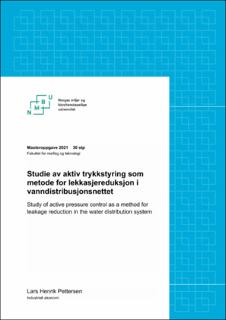| dc.contributor.advisor | Nilsen, Vegard | |
| dc.contributor.author | Pettersen, Lars Henrik | |
| dc.date.accessioned | 2021-12-29T14:18:12Z | |
| dc.date.available | 2021-12-29T14:18:12Z | |
| dc.date.issued | 2021 | |
| dc.identifier.uri | https://hdl.handle.net/11250/2835591 | |
| dc.description.abstract | Lekkasje i drikkevannsnettet er et stort problem i internasjonal sammenheng. I Norge utgjør lekkasjeandelen omtrent 31 % av alt behandlet vann transportert gjennom vanndistribusjonsnettet. Lekkasje av behandlet vann innebærer et stort økonomisk tap for samfunnet. Store summer penger investeres i distribusjon og behandling av vann, hvilket representerer et betydelig økonomisk tap ved store lekkasjeandeler.
I senere tid har fokuset i VA-bransjen skiftet i retning av lekkasjereduksjon. Det er godt kjent i miljøet at lekkasjeandel og trykknivå i systemet henger tett sammen. Trykknivået i ledninger må være balansert: for høye verdier fører til økt lekkasjefrekvens, samt økt risiko brudd og skader på infrastruktur. For lave nivåer kan medføre at vannforsyningen stanser opp i enkelte områder. Samtidig er det en økt risiko forurensning av drikkevannet ved lavt trykk. En metode som er testet ved flere forskjellige forsøk er aktiv trykkstyring. Metoden baserer seg på optimalisering av trykknivået i ledningsnettet til enhver tid, basert på metoder for dynamisk trykkstyring, hovedsakelig ved bruk av trykkreduksjonsventiler og pumper.
Dette studiet er bygget opp som et litteraturstudium. En del av oppgaven skal kartlegge ledningsnettets tilstand i norske kommuner som er sentrale i VA-sammenheng. Informasjonen innhentes ved mailutveksling med disse kommunene. En annen del av studiet innebærer et litteraturstudium av eksisterende fagstoff om temaet. Disse studiene blir gjengitt i dette studiet, som skal samle og oppsummere viktige erfaringer som er gjort med aktiv trykkstyring. Ettersom implementering av aktiv trykkstyring kan være kostbart, vil det også bli betraktet et kost-nytte-perspektiv ved studiet. Gir aktiv trykkstyring en økonomisk gevinst gjennom kostnadsbesparelser sammenlignet å la være og utbedre skader, og optimalisere trykknivåer?
Det kan konkluderes med, både fra spørreundersøkelse og litteraturstudium, at aktiv trykkstyring er en effektiv metode for lekkasjereduksjon, samt kostnadsbesparelser. Studiet fant at aktiv trykkstyring kan bidra til å optimalisere trykknivået i ledninger for å være i stand til å møte forbruket. I kombinasjon med vedlikeholdsarbeid og konvensjonell trykkstyring, kan aktiv trykkstyring gi både lekkasje- og kostnadsmessige besparelser under de rette forutsetninger. Det må analyseres i hver enkelt situasjon hvilket tiltak for aktiv trykkstyring som passer best, eller om det i det hele tatt omfatter god kost-nytte-verdi. | en_US |
| dc.description.abstract | Leakage in the drinking water network is a major problem in an international context. In Norway, the leakage rate is approximately 31% of all treated water transported through the water distribution network. Leakage of treated water means a great financial loss to society. Large costs are related to investments in the distribution and treatment of water, which is lost due to large leakage rates.
In recent times, the focus in the water engineering-industry has shifted in the direction of leakage reduction. It is well known in the environment that the proportion of leaks and the pressure level in the system are closely linked together. The pressure level in pipes and networks must be balanced: too high values may lead to increased leakage frequency, as well as an increased risk of breakage and damage to infrastructure. Too low levels can cause the water supply to stop in some areas. At the same time, there is an increased risk of contamination of drinking water at low pressure. One relevant method that has been tested in several different experiments is active pressure control. The method is based on always optimizing the pressure level in the pipeline network, based on methods of dynamic pressure control, mainly using pressure reducing valves and pumps.
This study is structured as a literature study in combination with a survey. A significant part of the task is to map the condition of the pipe network in norwegian municipalities that are central in a water engineering context. The information is obtained by email exchange with these municipalities. Another part of the study involves a literature study of existing literature on the topic. These studies are reproduced in this study, which will gather and summarize important experiences made with active pressure control. As the implementation of active pressure control can be costly, a cost-benefit perspective will also be considered in the study. Does active pressure control provide an economic benefit through cost savings compared to not repairing damage, and optimizing pressure levels?
It can be concluded, both from the survey and the literature study, that active pressure control is an effective method for reducing leakage, as well as cost savings. The study found that active pressure control can help optimize the pressure level in pipes to be able to meet consumption levels. In combination with maintenance work and conventional pressure control, active pressure control can provide both leakage and cost savings under the right conditions. It must be analyzed in each individual situation which measure for active pressure control is most suitable, or whether it at all includes good cost-benefit value. | en_US |
| dc.language.iso | nob | en_US |
| dc.publisher | Norwegian University of Life Sciences, Ås | en_US |
| dc.rights | Attribution-NonCommercial-NoDerivatives 4.0 Internasjonal | * |
| dc.rights.uri | http://creativecommons.org/licenses/by-nc-nd/4.0/deed.no | * |
| dc.title | Studie av aktiv trykkstyring som metode for lekkasjereduksjon i vanndistribusjonsnettet | en_US |
| dc.title.alternative | Study of active pressure control as a method for leakage reduction in the water distribution system | en_US |
| dc.type | Master thesis | en_US |
| dc.description.localcode | M-VM | en_US |

